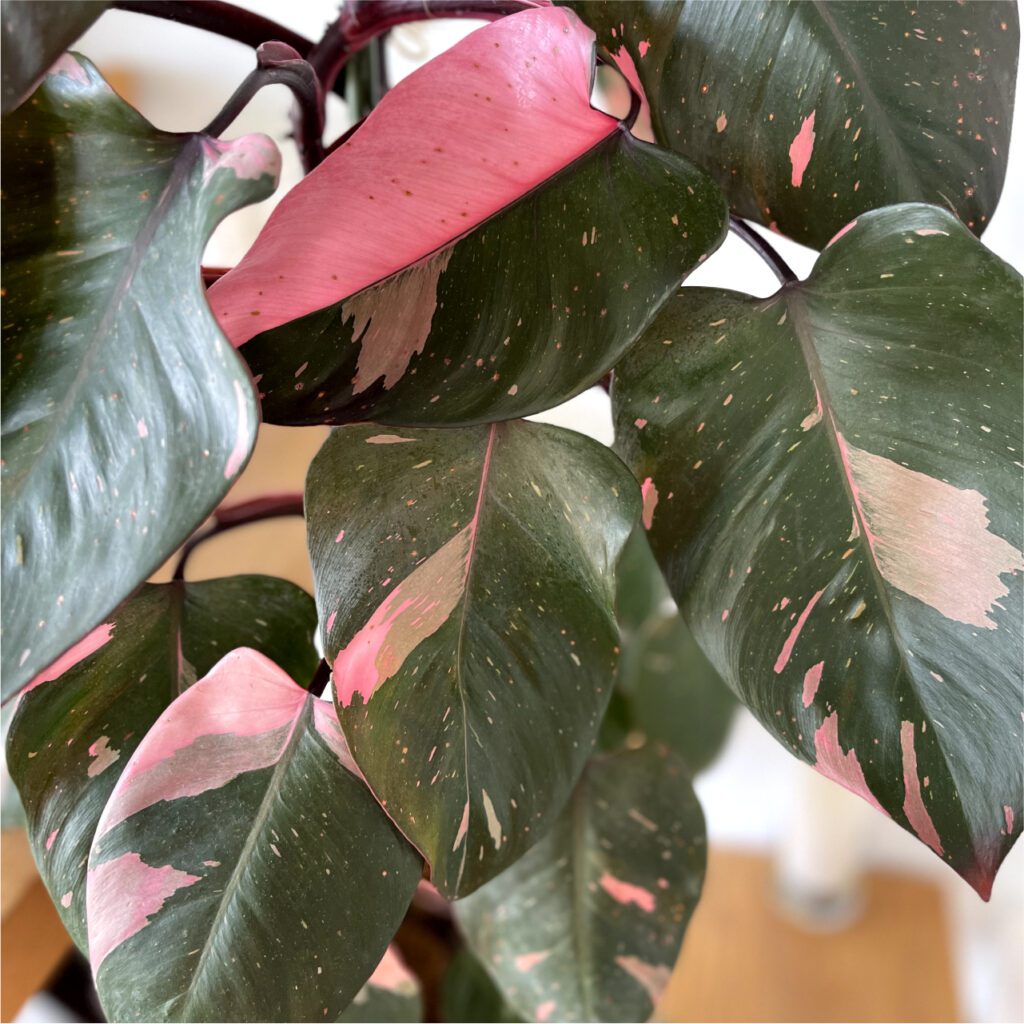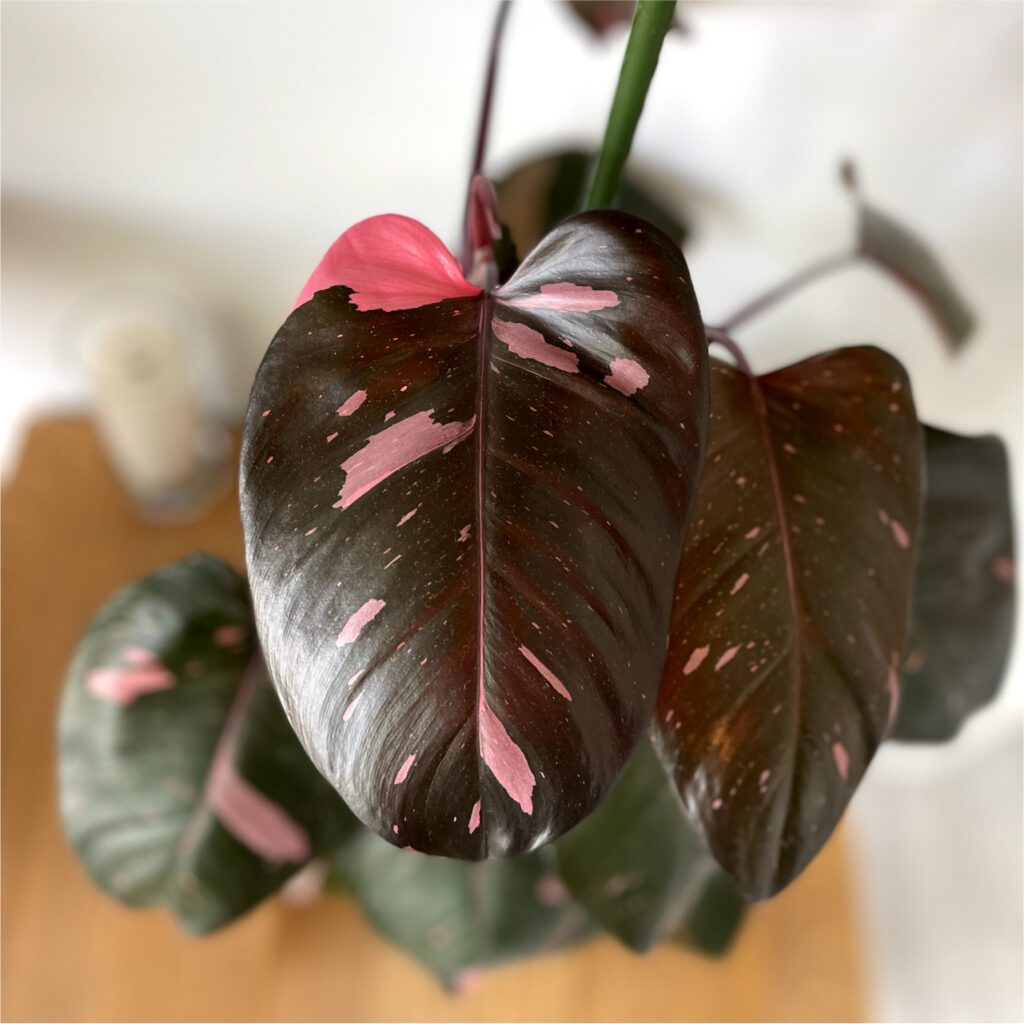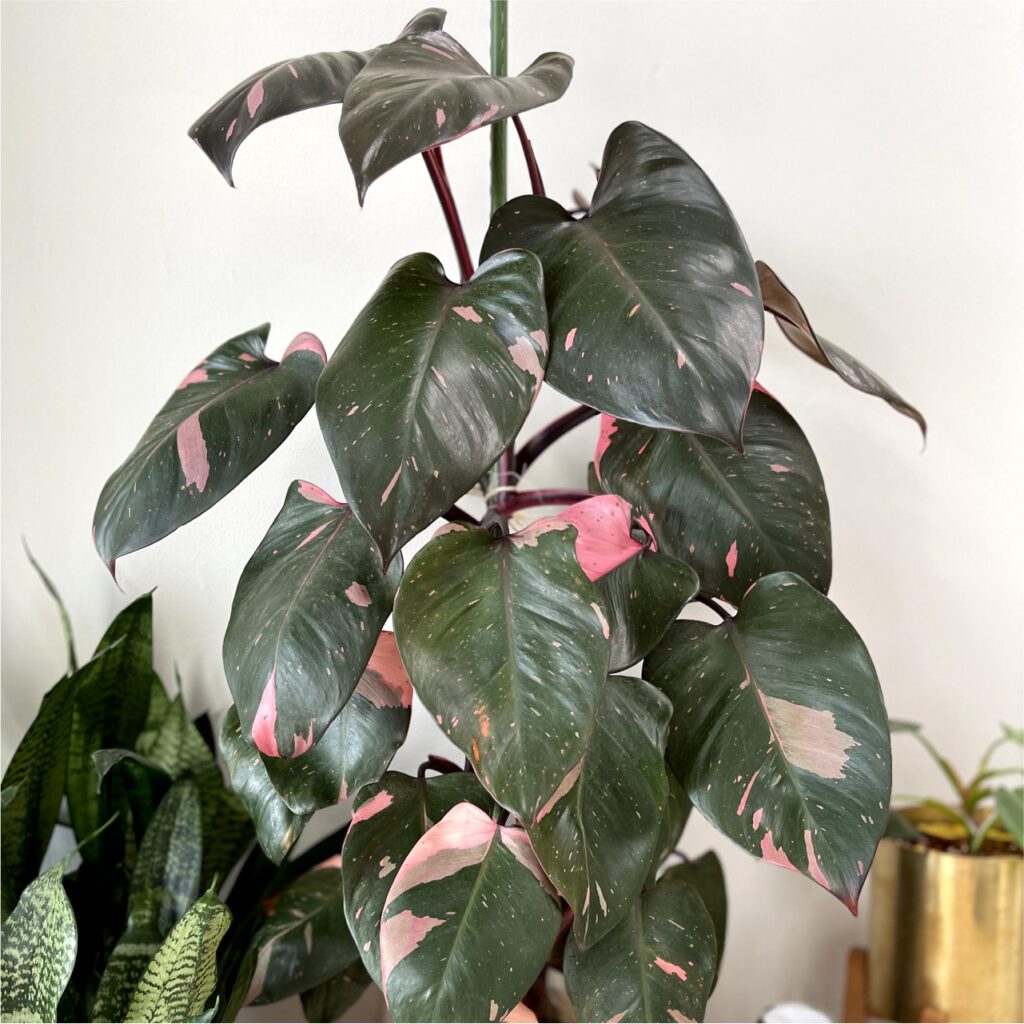The pink princess philodendron is one of the most unique and vibrant of all tropical plants. Unfortunately for the rest of your plant children, the pink princess philodendron can quickly steal the show in any space. With its surprising pink hue, the stunning foliage displays a radiance that practically glows against its contrasting deep green leaves.
Not only is this attractive plant eye-catching, but the philodendron pink princess easy is actually fairly easy to care for! As long as you provide your Pink Princess Philodendron with ample water, medium light, and moderate humidity levels. And if you play your cards right, you may even be surprised by a beautiful bloom. When well taken care of, your plant could climb moss poles and even walls with its upright growth habit and tenacious aerial roots.
Whether you’re an experienced indoor gardener or looking for an easy and fun first project, try out a pink princess philodendron – you won’t be disappointed!
Don’t be fooled by look-alikes!
Unfortunately, to the untrained eye, the Philodendron pink princess can easily be confused with the pink congo Philodendron. The two plants are actually quite different, but in their juvenile stage, they can look alike. The Philodendron pink congo has unstable variegation that can change over time, whereas the variegation of the pink princess is stable. The leaves of the Philodendron pink princess will also grow much larger than those of the Philodendron pink congo.
So what’s the deets?
-What is a Pink Princess Philodendron?
-Why is the Pink Princess Philodendron so Special?
-Where Does Pink Princess Philodendron come from?
-How do I take care of a Pink Princess Philodendron?
-Where do I get a Pink Princess Philodendron?


What is a Pink Princess Philodendron, or a Philodendron Pink Princess?
The Pink Princess Philodendron (or, if we’re being fancy, the Philodendron Erubescens ‘Pink Princess’) looks like a fairytale plant fit for a princess. But this pretty pink houseplant’s origins actually hail from South America.
The Pink Princess’s unique features have made it one of the most talked-about plants since it was first introduced to the horticulture trade in 2013. The Pink Princess is still revered as one of the most special tropical houseplants and has acquired quite a following over the years.
The rich dark green leaves are splashed with bright vibrant pink variegation and can reach up to eight inches long and five inches wide. A full-sized specimen of the philodendron pink princess can easily reach a height of four feet and nearly fill an entire corner in your living room!
With a little tender love and care, these happy-go-lucky Pink Princess plants can be lasting companions that bring a bit of beauty and royalty into any house or office setting.
Pink Princess, Pink Princess, Pink Princess! OMG. is that a Philodendron
Pink Princess?
The Pink Princess Philodendron are taking social media by storm! From Instagram to Facebook, and Pinterest to TikTok, the stunning philodendron with its pink and green variegated leaves has become one of the most popular houseplants of the decade. Plant lovers can’t help but swoon over pictures of its luscious leaves climbing up walls and spilling over tables. It’s no surprise that it has accumulated a massive online following! Everyone from beginner plant-keepers to more experienced green thumbs has been charmed by this unique plant; its unique pink variegation, simple care instructions, and durable nature have made this rare find a desirable addition to many households around the world. There’s no telling just how much bigger the Pink Princess Philodendron’s fan base will become in years to come!
Why is the Pink Princess Philodendron so Special?
The Philodendron pink princess is uniquely characterized by its deep blue-green, heart-shaped leaves with contrasting bubblegum pink variegation. This variegation occurs naturally and is stable, making the pink princess Philodendron a truly unique plant in the Aroid family.
This plant is truly unique and a must-have for any plant collector. Luckily if you are fortunate to come across one and have the funds to afford it, your hard-earned investment won’t be in vain.
Since being introduced into cultivation the pink princess philodendron has gained popularity among plant collectors and enthusiasts due to its rarity. The pink princess philodendron can only be grown from tissue culture in a lab, and only a few from each batch will reveal their pink variegation. This has made it a highly sought-after plant by many people. The Pink Princess philodendron is also known for its large social media presence, which has made it even more popular among plant enthusiasts.
Due to its rarity and beautiful appearance, the Philodendron pink princess is often at the top of many plant collectors’ wish lists. If you’re lucky enough to find one for sale, be prepared to pay a high price tag – it’s definitely worth it for such an amazing plant!
Where Does Pink Princess Philodendron come from?
The pink princess philodendron is quite an exotic beauty! Originating in tropical regions like Central and South America, this stunning plant can be found from Costa Rica all the way down to Bolivia. It grows naturally in rainforests and other tropical forests, so you can expect a lot of humidity for proper care. It isn’t a fan of direct sunlight but does enjoy indirect light coming from a nearby window.
Pink Princess Philodendrons are Long-Lived
Luckily the philodendron pink princess can last for a long time, with some having been around for more than 25 years! Besides having some serious longevity, it really gives off that sweet princess vibe with its frilly leaves, narrow petioles, and bright pink hue. All that’s left to do after getting one is treat it like royalty with lots of love and attention – perhaps even a crown or two!
How do I take care of Pink Princess Philodendron?
Taking care of a Philodendron Erubescens is fairly easy. Even caring for the Pink Princess variety is not a difficult task to do, but it does require attention and dedication. To ensure the health of this lovely plant, watering needs to be done regularly and carefully. Letting the soil dry out between waterings can help prevent root rot (Ugh, Root Rot!), which is common for Philodendron Erubescens Pink Princess.
Following these steps will help your Pink Princess Philodendron stay healthy, happy, and beautiful for years!
Watering
To keep the Pink Princess Philodendron in its best condition, here’s what you need to know:
- Be sure not to over-water your Pink Princess; let the top soil dry out between waterings, and be careful not to let any excess water stand in its pot as this can lead to root rot.
- Regular monitoring of the soil’s dryness is essential; if unsure about when to water your plant, stick your finger in the soil up to your middle finger joint and if it feels damp you don’t need to water it yet.
Lighting
This beautiful enchanting plant absolutely loves bright, indirect light or filtered sunlight! A spot near an east-facing window should do just fine.
For added lighting see my post on Lighting, GROW LIGHTS: WHY, WHEN AND HOW TO USE THEM
Humidity
Pink Princess Philodendrons thrive in humid conditions so misting them every few days or better yet, using a humidifier can really help up their health factor!
For added humidity see my post, 5 EASY WAYS TO IMPROVE HUMIDITY FOR YOUR HOUSE PLANTS
Temperature
The Pink Princess Philodendron does best in temperatures between 16˚C and 28˚C (60˚F and 82˚F). This temperature range usually falls into what most homes have. Remember they prefer a stable warm temperature while avoiding any cold drafts or direct blasts from a fan or air conditioner.
Fertilizer
Make sure that any fertilizer used has been diluted to half or quarter primarily phosphorus or ‘Bloom Booster’ type fertilizer as too much fertilizer can literally burn your Pink Princesses roots!
During active growth periods, use a general liquid fertilizer once a month. Keep it light on heavy applications as Philodendrons don’t like too much nitrogen.
Pruning
Lastly, don’t forget some occasional pruning (such as stems with dead leaves) – it’ll actually encourage more growth! So there you have it: take care of your Pink Princess Philodendron and you’ll be rewarded with beautiful foliage!
Taking care of Pink Princesses is a great way to bring a bit of nature into your home or office. This low-maintenance houseplant is hardy, easy to care for, and incredibly attractive – with the added benefit of purifying the air!


Where do I get a Pink Princess Philodendron?
If you want to bring a touch of royalty and glamour to your home, then a pink princess philodendron should be at the top of your list!
With its attractive deep green and pink variegated foliage, this unique houseplant is sure to make heads turn both inside and outside your home. As this is a rare variety, it may be hard to find in local nurseries. But luckily, all lovers of the pink princess philodendron can now order these plants online from specialty stores. Some even offer delivery directly to your doorstep- now who doesn’t love that convenience? Show off this rare plant’s stunning good looks anywhere in the house or balcony for everyone to admire.
Stay tuned for a link to my best plant sources, including the pink princess philodendron!
Propagating pink princess philodendron
Propagating pink princess philodendron can be tricky business. There are only a few real options, the most commonly used in a commercial setting is tissue culture. Where smaller producers may take cuttings from a mother plant. The traditional use of cuttings guarantees the plant’s variegation to be stable, with similar inherited patterns to the mother plant.
Tissue Culture
Propagating plants through tissue culture is a technique that has become increasingly popular for cultivating rare or endangered species like the Pink Princess. By using small pieces of the plant, such as buds and stems, and placing them in specific growing mediums, an identical clone of the original plant is produced. This technique ensures that rare plants can be protected from disease without risk to the existing population, and it also provides remarkable conservation benefits. Moreover, tissue culture makes it possible to store genetic material more safely while increasing their numbers exponentially. Overall this method can be used to improve crop production, reduce the vulnerability of horticultural species, and enable scientists to grow rare plants in a quick and reliable manner!
Bonus Content: What is an Aroid
Aroid plants are a family of plants that include philodendrons, anthuriums, and monsteras, to name a few. They are all tropical in origin and make excellent houseplants. Aroid plants are characterized by their large, showy leaves, which often come in shades of green, pink, or red.
Aroid plants are some of the most majestic and fascinating plants to behold – but they can also be some of the most mysterious. Aroids are a taxonomic family of flowering plants that includes philodendrons, elephant ears, and anthuriums. Usually found in tropical and subtropical environments, these amazing plants boast large waxy leaves in unique colors, making them attractive additions to any home-grown garden.
These lovely plants require more care than other varieties, as they need high humidity levels and regular repotting for optimal health. But for those willing to put in the effort, aroids offer their full beauty and make a truly captivating sight that is sure to turn any collection into something special!
Aroids are one of the most remarkable types of plants out there! These weird and wonderful specimens are known for their modified structure, which consists of a large collection of roots that all cluster toward the center like ramen noodles. Aroids are native to tropical and semi-tropical climates, and can often be seen with their big umbrella-like leaves on display. Don’t let their exotic look fool you though – these resilient plants require little maintenance, as long as they have access to enough water and indirect light. With the right care, people can enjoy these gorgeous foliage stars for years to come!
Aroids are some of the most fascinating and hardy plants out there. They comprise a distinct family of more than six thousand species, from flowery blooms to deep-green spades. They’re known for their vigorous growth and resilience towards almost any type of environment, making them an ideal choice for green thumbs who want to achieve a dense jungle-like look.
From Pink Princess Philodendron to the ZZ Plant (Zamioculcas zamiifolia) and many others, these easy-to-care plants can light up any space – literally! Many of them feature shiny foliage with incredible colors that can create a surreal ambiance no matter where you place them. If you’re looking for a truly eye-catching addition to your space, go ahead and grab an aroid!
There are many different varieties of Aroids available, each with its own unique characteristics. The Philodendron genus is probably the best-known Aroid and includes both upright and trailing species. The Anthurium genus is known for its bright red spathes (the petal-like structure that surrounds the flower). Monstera is a genus of climbing Aroids with large leaves that can reach up to 2 feet in diameter.
I hope you have fallen for the Pink Princess Philodendron as I have!
Remember despite its rarity, the pink princess Philodendron is not difficult to care for and is well worth the effort. So don’t wait any longer, brighten up your space by adding this special gem! Go and grow Pink Princess Philodendron today!
